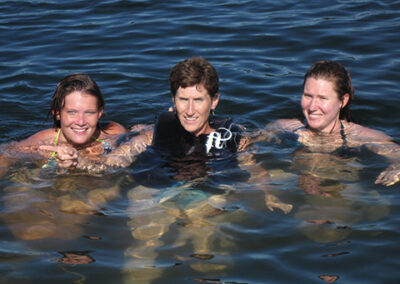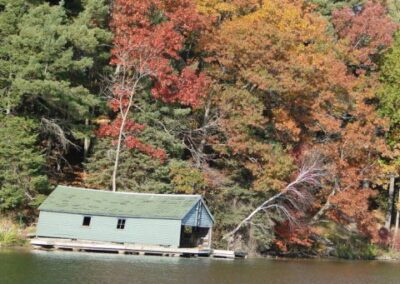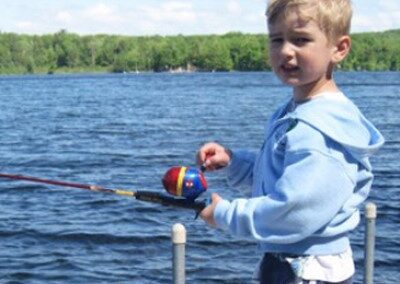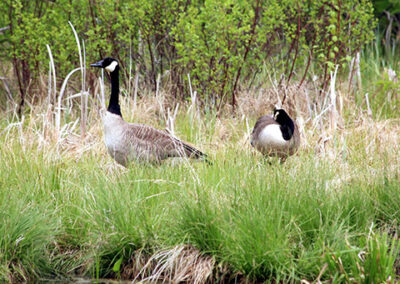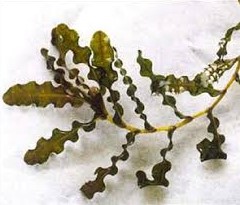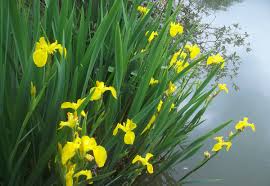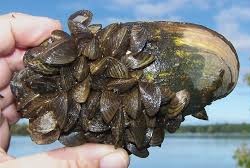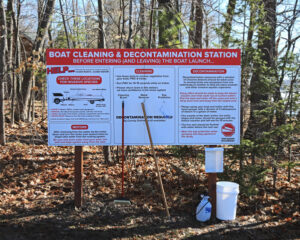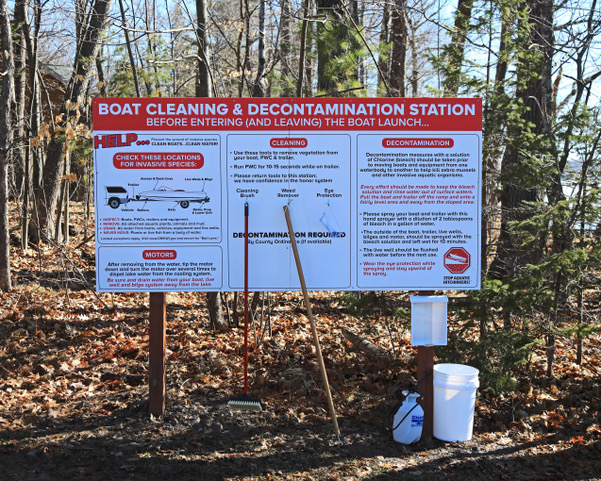About Our Lake
Our Projects
AIS (Aquatic Invasive Species)
AIS (sometimes called exotic, nonindigenous or non-native) are aquatic organisms that invade ecosystems beyond their natural, historic range. Their presence may harm native ecosystems or commercial, agricultural, or recreational activities dependent on these ecosystems. Listed below is information on two AIS that have been found in Long Lake, Curly Leaf Pondweed and Yellow Flag Iris, and one which has invaded a nearby lake, Zebra Mussels. If you have any questions concerning the removal/disposal procedures for AIS, feel free to contact Lisa Burns, Washburn County Land & Water Conservation/Aquatic Invasive Species specialist.
CURLY LEAF PONDWEED
Curly Leaf Pondweed (CLP) is an invasive aquatic plant which has been present in Long Lake for some years. Until recently it did not form significant beds thick enough to interfere with navigation; a 2004 survey by UW Stevens Point reported that its presence was not yet significant, but predicted that would likely change.
That prediction was, unfortunately, accurate. Commencing in 2014 LLPA has annually mapped CLP with a mapping GPS unit along the entire shoreline and other shallow areas. Each year’s results are printed onto a map, with each year being color coded so year to year changes are apparent, and it is apparent that CLP has spread. In 2017 in particular it was found far from earlier locations. For reasons which are unclear, but possibly related to the late ice out, 2018 was a “down” year for CLP; there wasn’t enough growth to successfully map. Anecdotal evidence suggests this was true of other lakes in the area as well. It had returned in 2019 and again in 2020, but subjectively appeared less dense than in 2017 and did not appear to have extended its range. We thus elected not to clutter the maps with additional colored dots which wound be of little significance. Inspections will continue to be made, and if expansion becomes evident the maps will be updated.
The 16 maps generated following the 2017 survey are at the link below. The first page is a whole lake overview. It is followed by more detailed maps, commencing at the Long Lake Road culverts at the far north end and working down the lake, around Christiana Point and up to the Elvers Road culvert at Lower Mud Lake.
CLP Maps
The problem with CLP is that, like most invasives, it can crowd out native species and form dense mats at and near the surface, impeding navigation and even restricting the ability of fish to swim freely. This results because it starts growing under the ice, giving it a head start on most native plants. The positive in this is that it also dies out early, usually by mid-July.
Efforts to control CLP by use of herbicides has not proven effective in the long term. There was a school of thought that chemical treatment of a given area for three consecutive years would result in long term control. LLPA did attempt this at some beds just downstream of the Narrows. Control was effective during the years of application, but after three years there were no lasting effects. Annual treatment of large areas would be very expensive..
LLPA is exploring possible options, and will continue annual mapping to monitor further expansion. For now, the best solution for individual landowners is to manually pull the plants from around docks and lifts and dispose of them in the trash. This should be done as early in the summer as possible, as the mature plants form seed pods (called “turions”) which, when the plant is pulled, fall to the bottom where they may sprout the following year or even several years hence.
YELLOW FLAG IRIS
Yellow Flag Iris is a relative newcomer to Long Lake. Aside from color, it resembles the familiar native Blue Flag Iris, and is equally appealing in appearance. But there the similarities end. Growing along the shoreline, it expands quickly and can form dense stands which crowd out aquatic plants such as cattails and native irises. Its root system also forms dense mats which inhibit the growth of other plants. It expands by spread of its rhizome root system and also produces floating seed pods.
While at this time it is present only in small clumps in Long Lake, mostly along the developed shoreline between the Narrows and Crows’ Nest, it appeared to be present in more locations in 2017 than in prior years. Small clumps can be controlled by digging up the plant, but care must be taken to remove all rhizomes, as they can persist for more than ten years in soil. Be sure to dispose of them in the trash, not a composter, for even a dried rhizome can survive for over three months. Gloves should be worn while handling because the sap can cause skin irritation to sensitive persons. All parts of the plant are toxic, especially the rhizomes.
ZEBRA MUSSELS
Zebra Mussels are an invasive species which has not been found in Long Lake, but it has invaded the area. Recent LLPA newsletters have reported on their appearance in nearby Big McKenzie Lake, which lies partly within Washburn County.
Zebra Mussels are comparatively small, usually about the size of a fingernail. Their strength, and their danger, is in their sheer numbers. They have the potential to be extremely damaging largely because they are incredibly prolific. A single female can lay up to one million eggs per spawning season, and even at a survival rate of only two to five percent the population can mushroom. They tend to attach to hard surfaces, and when the population grows enough they clog water intakes and boat motors, attach themselves to native mussels, and shells of the dead wash ashore in great masses, cutting the feet of anyone attempting to wade there. Perhaps most significantly they out-compete native species for food by voraciously filter feeding on organisms at the base of the food web.
In our area Zebra Mussels have few natural enemies, and hence their rapid reproduction. Carp are known to feed on them, but introduction of carp for that purpose would be a definite leap from the frying pan to the fire. Some success has been reported treating infested water with a form of dead bacteria which disrupt their digestive system, as well as with a copper based product, but those techniques are far from proven yet, and can be extremely expensive. Research on how best to control them is continuing.
The best defense against them is to keep them out of the lake in the first place. That can be difficult because of how they spread. Since they are small one or two attached to a boat hull or outboard lower unit may not be obvious absent careful inspection. They can live out of water for several days, especially in cool weather. Even more significantly, their free-floating larva start out as being microscopic, undetectable by the human eye. That is why it is so important to follow the rules about not transporting water from lake to lake. Visual inspection alone is not enough. Drain everything.
LLPA has continued Clean Boats Clean Water inspections at major landings. Additionally, because early detection gives at least some hope of control we have built Plexiglas devices known as collector plates and suspended them from docks at landings, the idea being that if they are present they will attach. Thus far all inspections have been negative, but only continual vigilance and adherence to the no water transport rules by every boater can keep them at bay.
Decontamination Station
Most recently LLPA and the Long Lake Chamber of Commerce have jointly erected decontamination stations at the four major public landings.
Decontamination FAQ Sheet
Each station consists of a 4×8’ sign with a cleaning brush, weed removal hook, goggles and a one gallon sprayer containing a mild bleach solution. The bleach solution is targeted at larva of Zebra Mussels. Two of the stations were supplied by the Washburn County Land and Water Conservation Department, aided by a WDNR grant, and two were purchased by LLPA and the Chamber.
The bleach solution is for spraying all portions of boat, motor and trailer exposed to water. Directions are plainly set forth on the sign. Since the active ingredients of the bleach break down chemically in a day or two, volunteers are needed to replenish it during the boating season; anyone willing to help should contact any LLPA board member.
It should be noted an Ordinance enacted by Washburn County in 2018 provides that if a decontamination station is available at a landing, it shall be used in accordance with the posted instructions. We all appreciate that this adds a little time unloading and loading, but if that helps keep invasives, especially Zebra Mussels, out of Long Lake, it is worth the effort many times over.
For more information on these and other invasive species known to exist in Washburn County, go to:
Water Testing
Since its inception LLPA has participated in what is now known as the Citizens Lake Monitoring Network (CLMN), a Wisconsin DNR sponsored system of water quality testing and data management. Once a month starting shortly after ice out volunteers visit six pre-established sites on the lake to perform testing. Water clarity is checked by lowering a Secchi disk and recording the maximum depth at which it is visible. (Current year-to-date results are shown here.) Then a dissolved oxygen meter is used to record temperature and dissolved oxygen levels at one, three and five foot levels and at every five feet thereafter to the lake bottom. The collected data is then uploaded to a DNR site known as SWIMS (Surface Water Integrated Monitoring System). Learn more about the Wisconsin DNR CLMN program.
At two of the sites water is collected from the upper six-foot water column. Back on shore a measured amount intended for phosphorus testing is treated with acid (to destroy microorganisms which might alter phosphorus measurements) and another measured sample is drawn through a filter by use of a vacuum pump to collect chlorophyll. The water sample and filter are then packed in ice and mailed to the State Laboratory of Hygiene in Madison where they are tested and the results are forwarded to DNR.
Even a single days testing gives a snapshot of water quality conditions, but more significantly over time the data indicate trends in lake health. Both raw data and interpretative reports are available online. Testing history for all participating Washburn County lakes, including the six Long Lake sites, can be found here.

Fish Sticks
Trees fall into lakes. They always have. And until about the dawn of the twentieth century they stayed where they fell, providing habitat for everything from the bottom of the aquatic food web to the top. Research has shown that a single tree can support 15 or more species of fish simultaneously. But shoreline development has changed all that, with most windfalls being removed, and with them the habitat they provide. A good summary of studies in this field is in the UW-Stevens Point publication “A Second Life for Trees in Lakes.”
Fish Sticks is a program to help replace that habitat. Fish sticks are composed of freshly cut live trees (live so they sink) cabled together in bundles of three to five trees, which are then placed perpendicular to the shoreline and anchored by cable to a sturdy standing tree. Several such bundles are placed about 50 feet apart along the shoreline. This is done in winter time; at ice out the trees sink.
LLPA, in partnership with Camp Tomahawk, constructed Long Lake’s first Fish Sticks project in 2015. A second project was constructed in early 2018. Both projects are located along Scout property across the lake from Hank’s Landing, which is on Todd Road.
In 2019 a third Fish Sticks project was added. This one is located close to the Scout Lodge on the “thumb” of Long Lake, near the tall flag pole. In 2020 two more sites were constructed nearby, this time in conjunction both with Camp Tomahawk and the Long Lake Chamber of Commerce.
In February of 2021 and 2022 the LLPA, the Long Lake Chamber of Commerce and Camp Tomahawk partnered together to place Fish Sticks in three more locations along Scout Camp property. Two of these are just south of the 2015 and 2018 locations and the third is next to the island across from the old Crows Nest resort.
Here is a map showing the location of the Fish Sticks placed to date.
In these projects the trees were able to be cut near the project sites on Camp Tomahawk land, where suitable trees are plentiful. Not all shoreline is suitable for fish sticks, and sometimes trees must be hauled in from other locations. If interested, find out more from DNR’s Fish Sticks website.

Clean Boats / Clean Water
Most recently LLPA and the Long Lake Chamber of Commerce have jointly erected decontamination stations at the four major public landings.
Decontamination FAQ Sheet
Each station consists of a 4×8’ sign with a cleaning brush, weed removal hook, goggles and a one gallon sprayer containing a mild bleach solution. The bleach solution is targeted at larva of Zebra Mussels. Two of the stations were supplied by the Washburn County Land and Water Conservation Department, aided by a WDNR grant, and two were purchased by LLPA and the Chamber.
The bleach solution is for spraying all portions of boat, motor and trailer exposed to water. Directions are plainly set forth on the sign. Since the active ingredients of the bleach break down chemically in a day or two, volunteers are needed to replenish it during the boating season; anyone willing to help should contact any LLPA board member.
It should be noted an Ordinance enacted by Washburn County in 2018 provides that if a decontamination station is available at a landing, it shall be used in accordance with the posted instructions. We all appreciate that this adds a little time unloading and loading, but if that helps keep invasives, especially Zebra Mussels, out of Long Lake, it is worth the effort many times over.
For more information on these and other invasive species known to exist in Washburn County, go to:
- AIS Guide
- AIS by County
- Curly leaf pondweed
- Japanese knotweed description
- Rusty Crawfish
- WI DNR Informational Invasive Species Web Links
- Yellow Flag Iris
Rain Gardens & Maintenance
Hunt Hill is the permanent site of a green and growing collaboration between LLPA, the Audubon Sanctuary and UW-Extension. With the help of Master Gardeners, and others who attended the free how-to sessions, three impervious surfaces there now drain into rain gardens. The practice of planting native perennials in swales dug out to collect and cleanse storm water and snowmelt is climbing the charts of lake stewardship. In Seattle, Madison and suburban Twin Cites, entire neighborhoods and even some commercial sites have incorporated rain gardens. As an individual effort, anyone with shovel, wheelbarrow and trowel can make a significant difference in preventing fine sediment and pollutants associated with development from entering storm sewers, streams and lakes.
How to build a rain garden – manual
The rain gardens planted at Hunt Hill were designed to trap and filter runoff from the office, barn and a dorm. Each demo plot took into account slope, soil type, sunlight and surface area it would drain—in each case a roof. Downspouts direct storm water to the gardens, where it percolates through the soil and recharges the groundwater instead of racing across the lawn to the lake. Native plants were selected because they require minimal maintenance, no fertilizer and no pesticides. Each garden was mulched to retain moisture and choke out weeds, and down slope berms were seeded for easy mowing. Hunt Hill’s longtime conservation ethic means its slopes are not heavily contaminated by construction debris; automotive fluid leaks; household chemical, paint and wood preservative spills; and bacteria-laden pet waste. Or sedimentation from bare dirt piles, which kills off littoral zone fish and amphibian egg clusters. Or phosphorus from excess fertilizer, which grows whopper algae blooms.
But what’s happening at our homes? Even car-washing suds that pour off pavement and accumulate on lawns carry chemicals harmful to aquatic life. Since no one seeks out lakefront property only to have a dead zone offshore, it behooves each of us to practice lake-friendly living. Rain gardens contain storm water for only a short time, avoiding mosquito breeding. While doing so they create beauty and intensify life. Wouldn’t we all enjoy more blooms and butterflies, dragonflies and ground-nesting songbirds along our shores? The EPA calls polluted runoff “the nation’s greatest threat to clean water.”
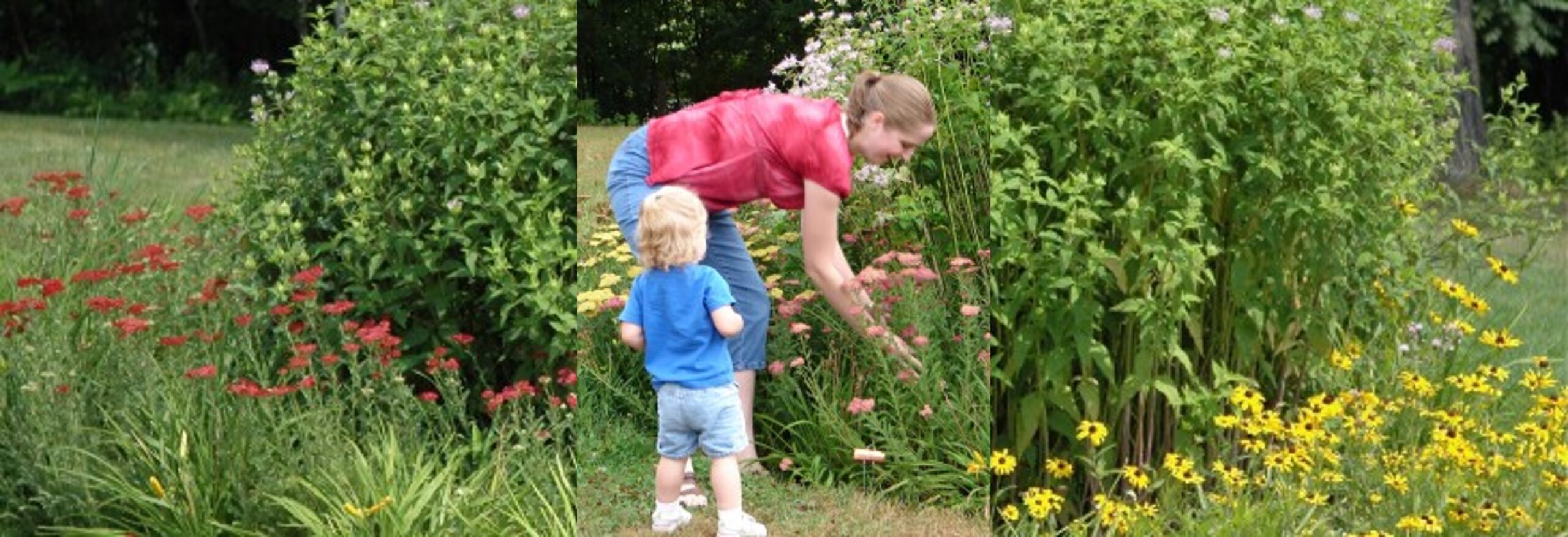
Boat Landing Kiosks
The LLPA kiosk project was undertaken in conjunction with the Department of Natural Resources. Seven kiosks were built and placed at various watershed landings, including five on Long Lake. The additional kiosks are at Slim Creek Landing and on Little Devil’s Lake.
The structures are designed with a large display area for posters and information pertaining to DNR rules and regulations. Below is an area designated for informative pamphlets and cards identifying various exotic species. This LLPA project will provide updated and timely information for watershed visitors and riparian owners through the years, as people take advantage of the literature displayed.

Partners
Tomahawk Scout Reservation, operated by the BSA Northern Star Council of Minnesota, is located in the center of the “fish hook” on Long Lake. Encompassing 3,000 acres and 12 miles of shoreline, Tomahawk is home to the council’s summer Boy Scout and Webelos resident camps as well as the Snow Base Winter Camp. The Camp hosts LLPA’s annual meetings, and its Director is an ex officio (automatic) member of the LLPA Board of Directors.
A collaborative agreement between LLPA and Hunt Hill Nature Center involves Hunt Hill as our partner in watershed education, hosting our Cakes at the Lake programs and serving as the site of most Board of Directors’ meetings. LLPA also rents storage space there.
- Hunt Hill – hunthill.org
- Long Lake Chamber – longlakewisconsin.org
- Red Cedar Lakes Association – redcedarlakes.com
- Slim Lake Association
- Tomahawk Scout Camp – camptomahawk.org
- Walleyes for Tomorrow – walleyesfortomorrow.org
- Washburn Cty Extension – washburn.uwex.edu
- Washburn County Land & Water Conservation Department – co.washburn.wi.us
- WCLRA / Washburn County Lakes and Rivers – wclra.org
- WI DNR – dnr.wi.gov
- Wisconsin Assoc. of Lakes – wisconsinlakes.org
Current Lake Conditions
Water Clarity
LLPA water testing includes testing water clarity with a Secchi disk several times per summer. The five primary sites are as indicated on the accompanying map.
Water clarity results (measured in feet) for the recent years are shown in the following tables:
| Location | North End | Kunz Island | South End | Thumb | North Narrows |
| Date | A | C | D | E | F |
| May 2024 | 7.0 | 11.0 | 12.0 | 10.5 | 7.5 |
| May 2023 | 10.0 | 9.5 | 8.0 | 10.0 | 9.5 |
| May 2022 | 8.5 | 8.0 | 8.5 | 8.0 | 6.5 |
| May 2021 | Missing Data | Missing Data | Missing Data | Missing Data | Missing Data |
| Date | A | C | D | E | F |
| June 2024 | 8.0 | 8.5 | 9.0 | 11.0 | 10.0 |
| June 2023 | 13.5 | 14.5 | 13.0 | 13.5 | 13.0 |
| June 2022 | 8.0 | 9.5 | 10.0 | 9.5 | 8.5 |
| June 2021 | 9.5 | 14.0 | 14.0 | 13.0 | 11.0 |
| Date | A | C | D | E | F |
| July 2024 | 7.5 | 11.5 | 12 | 12.5 | 8.5 |
| July 2023 | 10.5 | 12.5 | 14.0 | 14.0 | 11.5 |
| July 2022 | 6.5 | 9.5 | 11.0 | 12.0 | 7.5 |
| July 2021 | 6.0 | 10.0 | 10.5 | 11.0 | 7.0 |
| Date | A | C | D | E | F |
| August 2024 | 5.5 | 9 | 10 | 10.5 | 5.5 |
| August 2023 | 7.5 | 10.0 | 11.0 | 13.0 | 9.0 |
| August 2022 | 10.5 | 9.0 | 9.5 | 8.5 | 9.5 |
| August 2021 | 6.0 | 7.0 | 7.0 | Missing Data | 8.0 |
Wildlife Inhabitants

Bears
Photo Courtesy of Barb Ray
Living With Bears in Wisconsin
Black bears are commonly found in the northern third of Wisconsin, but are being sighted more frequently in the central and southern counties of Wisconsin as they expand their range. As the black bear population continues to grow, so do an increasing number of bear-human conflicts. In order for bears to coexist with humans, we have to understand normal bear behavior. Black bears tend to be shy, solitary animals, but at some times of the year, particularly in the spring when bears emerge from their winter dens and food is not abundant, bears may be on the lookout for opportunistic food sources. This might be your garbage can, or the bird feeder in your back yard. Nearly all human-bear conflicts are a result of the animals’ search for food. There are lots of simple things you can do to avoid conflicts with bears. With your help we can continue to live together with this great animal, enjoying their presence in the woods around us and at the same time reducing conflicts with bears around our homes and our campsites.
REDUCING BEAR CONFLICTS NEAR YOUR HOME
Black bears are attracted to numerous items around homes, including: bird feeders, compost piles, grills, pet food, gardens, and garbage. Here are some simple recommendations to avoid problem bears:
Bird Feeders
- Make bird feeders inaccessible to bears by hanging them at least 10 feet off the ground, and 5 feet away from tree trunks, or on a limb that will not support a bear (you can still refill the feeder easily by using a pulley system).
- Consider taking bird feeders down at the end of winter (mid-April) when bears emerge from their winter dens.
- During spring and summer, bring feeders inside at night, a time when bears frequent stations.
- Clean up spilled bird seed below feeder stations.
- If you see a bear at a bird feeder during the day, take the feeder down and discontinue all feeding for at least two weeks.
Garbage Cans
- Keep your garbage cans tightly closed, and indoors if possible.
- Pick up loose or spilled garbage so that it doesn’t attract bears.
- Occasionally clean out your garbage cans with ammonia to make them less attractive to bears.
And a few more…
- NEVER FEED A BEAR! Intentional feeding will create a bear that is habituated to humans, and may become a possible nuisance to you and other people in the area. The bear will not forget the feeding experience, and will tend to get more demanding with time.
- Bring in pet food at night.
- Clean up and put away outdoor grills after you are done using them for the day.
WHEN YOU ARE CAMPING
- Don’t cook, eat, or store food in your tent! The smell of food may attract bears.
- Store food and cooking utensils away from your campsite, preferably in a vehicle or hung in a tree at least 10 feet off the ground and 5 feet out on a limb that will not support a bear.
- Dispose of scraps in closed containers away from your campsite, not in the fire.
- Keep your campsite clean.
IF A BEAR IS CAUSING A NUISANCE IN YOUR AREA
Contact the U.S. Dept. of Agriculture Wildlife Services. In the northern half of Wisconsin, call 1-800-228-1368, or in the southern half of Wisconsin call 1-800-433-0663. They can help you by providing additional information on reducing or eliminating your specific problem. If the situation is severe and presents a threat to health and human safety they can also remove the bear from the area.

BLACK BEARS AND AGRICULTURAL DAMAGE
With a healthy black bear population, it is inevitable that black bears may damage agricultural crops in some areas. Particularly tasty treats are apiaries (beehives) and corn fields in the milk stage. Bears also occasionally attack livestock. The Wildlife Damage Abatement & Claims Program (WDACP) is available to help Wisconsin farmers whose crops or livestock are damaged by bears. If you would like more information on this program, please contact the Wildlife Damage Specialist at (608) 266-8204 or write us at
WI DNR, 101 S. Webster St. (WM/6)
P.O. Box 7921,
Madison, WI 53707-7921.
Facts about Wisconsin’s Black Bear
Weight: Males, 250-300 lbs; females, 120-280 lbs.
Body Characteristics: Bears appear bulky and are glossy black, with a tan patch across the nose. Brown and cinnamon colored bears appear less often.
Reproduction: Black bears are sexually mature at 3 years of age. Females will breed every other year from then on. Mating takes place from June to early July. During the 225-day gestation period, the fertilized egg experiences delayed implantation until late November or early December. Females then give birth to two to three cubs in January or early February while they are still in their winter sleep!
Cubs: At birth, the bear cubs weigh 7-12 oz. Their eyes are closed and fur is sparse. Growth takes place quickly. Cubs will first venture into the world with their mother in late March. They remain with their mother through the summer and usually den with her the following winter. In the springtime, the mother will chase off the cubs so she can breed again.
Diet: Bears are omnivorous, meaning they will eat almost anything! Their diet generally consists of vegetation, insects, berries, and nuts. Occasionally they eat carrion and small animals. They also target livestock, beehives, garbage, and agricultural crops.
Habitat: Large forested areas with swamps and stream bottoms, and areas with minimal development are good habitat for black bears They are also found around thick ground vegetation with lots of trees and bushes that produce nuts and berries. Fallen trees provide bears with locations to dig a winter den.
Behavior: Bears are typically shy and secretive animals; most go to great lengths to avoid humans. Bears typically wander over long distances. Home ranges are about 27 square miles for males, and about 8 square miles for females. Black bears are most active around dusk, but may be out and about any time of the day or night. Mid-May to late September is the period of most activity.
Winter Sleep: Bears are not true hibernators! During the winter months bears “den up” where they will fall into a deep sleep. During this time bears live off the body fat they have accumulated during the fall. Their body temperature, heartbeat, and respiration decrease, but not to the level where hibernation occurs. Dormant bears can be easily awakened from their winter sleep!
IF YOU SEE A BLACK BEAR
- Make noise and wave your arms—let the bear know you are there so you don’t surprise it. Bears normally leave an area once they know a human is around.
- If you happen to surprise a bear at close range, back away slowly.
- If you are near a vehicle or building, go inside until the bear wanders away.
- Do not approach a bear. Respect black bears as wild animals and enjoy them safely—from a distance.
WEBSITES WITH ADDITIONAL INFORMATION
Information Courtesy of Wisconsin DNR Wildlife Education
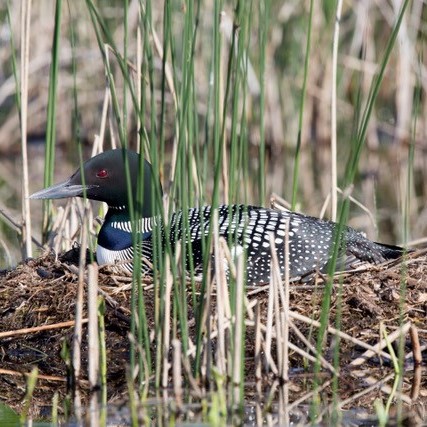
Loons
Listen. That eerie sound you hear is not a ghost haunting a northern lake. It’s the call of the common loon. This bird, whose ancestors roamed the earth 65 million years ago, can be found on Wisconsin’s northern lakes in the summer. They come here to breed and raise their young. Come fall, they head to the ocean coasts to overwinter. (You can track migrating loons as part of a loon migration study.)
What’s for dinner?
Common items on the loon’s menu are perch, bullhead, and sunfish. They’re also known to eat frogs, crayfish, and even leeches—yum,yum. Check out the loon’s long, pointed beak—the better to grab fish and other goodies. The loon dives underwater to grab its prey and then swallows it in one gulp.
Living on the water
Loons are made for living on the water. The torpedo-like body is streamlined for swimming underwater. The legs of a loon are set far back on its body to work like oars with its large webbed feet. The body color, dark on top and light on the bottom makes loons less visible to fish as they swim. Some scientists think the loon’s red eyes help it see better underwater.
Because the loon’s legs are so far back on its body and because its body is so long, loons have trouble taking-off. Have you ever seen a loon “running” across a lake? A loon has to run across the water for up to ¼ mile beating its wings in order to get enough lift to take off. This need for a long runway means that loons need a certain size lake in order to take off. You’ll rarely find a loon in lakes under 9 or 10 acres.
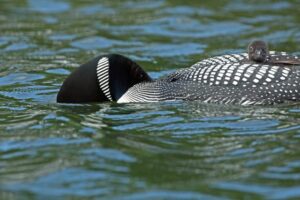
The loon dance
When disturbed the loon folds its wings against its body and swims upright in what is called a penguin dance. With its wings tucked against its body it looks kind of like a penguin. This dance is done when the loon is trying to scare enemies away from its chicks. “Dancing” like this takes a lot of energy so it’s important that you keep your distance from loons. If you get too close to it and its chicks or nest, the loon will think you’re its enemy and start the penguin dance. If you don’t leave the area, the loon can dance until it’s exhausted and dies.
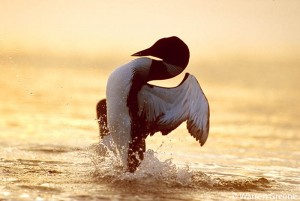
The loon has another dance that it does when it wants to chase away other birds. It splashes the water with its wings and kicks its feet so quickly that it is actually walking on water.
Loon nests and hitchhikers
Loons are fast in the water but have trouble walking on land. They don’t spend much time on land, except to nest. Their nests are made of weeds and grass and are usually located in grass along the lake shoreline. A loon may use the same nest year after year. Two olive-brown eggs are laid. Crows, ravens, gulls, skunks, mink and raccoons (especially raccoons) eat the eggs. Both male and female loons take turns sitting on the eggs. The eggs hatch in about one month. Soon after the eggs hatch, the chicks are in the water swimming with their parents. Swimming in the cold water is hard on the chicks, so from time to time they hitch a ride on their parent’s back. This also protects them from predators like snapping turtles and muskies.
Loon Watch
In 1978, the Sigurd Olson Environmental Institute in Ashland, Wisconsin started a loon conservation program. In 1988 it was combined with a program in Minnesota and given the name LoonWatch. This program trains volunteers to help protect loons and their habitats; track loon populations; and educate people about loons. It also sponsors research and education about loons. In July hundreds of Loon Watch volunteers will get up before the sun to go count loons on more than 250 lakes. The results of this survey will help biologists track the number of loons in Wisconsin.
Loon Watch, its Advisory Council, and volunteers are all working toward common goals of loon conservation and protection. For more information about the program, contact the Sigurd Olson Environmental Institute at Northland College, (715) 682-1220, or email loonwatch@northland.edu.
Loon lore
There are many Native American stories about loons. The Ojibwa (Chippewa) Indians called the loon “Mang” or “the most handsome of birds.” They thought the loons’ haunting cry was an omen of death. In some native legends the loon is a bird of magical powers, in others a messenger or a symbol of power. You can read some of these Native American stories in “Loon Book” by Tom Hollatz. Your public library should have a copy.
If you get a chance to visit Long Lake this summer, listen for the haunting call of the common loon.
Loon Resource Links and Audio/Video Files
Wisconsin loons have been dying from botulism toxicity while migrating through the Great Lakes in the fall, including our banded adults and juveniles. Attached you will find a YouTube video that describes the issue very nicely.
Check out Kevin Kenow’s USGS website to learn what work is ongoing here in Wisconsin to understand the link between invasive species and loon mortality.
Loon Calls
Loon calls at night. Experience the sounds of the Northwoods
Long Lake Loon Ranger
Byron Crouse, (715) 635-6518
Please call or email Byron to report a loon on a nest or a loon in danger/distress
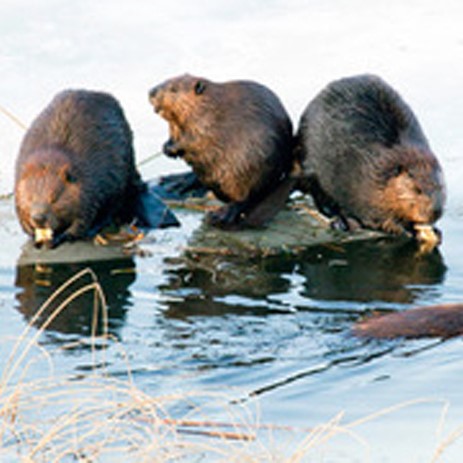
Beavers
The Beaver is North America’s most common and largest rodent. Their most distinctive feature is their large flat tail, which serves as a rudder when swimming, a prop when sitting or standing upright, and it is a storehouse of fat for the winter. They are an aquatic mammal with large webbed hind feet ideal for swimming and hand-like front paws that allow them to manipulate objects easily. They have excellent senses of hearing and smell. When swimming under water a protective transparent membrane will cover their eyes and a flap closes to keep water out of their nostrils. They also have inner lips to keep water out when carrying sticks in their mouth. Beaver fur consists of short fine hair for warmth and longer hair for waterproofing.
Beavers are pure vegetarians, subsisting solely on woody and aquatic vegetation. They will eat fresh leaves, twigs, stems, and bark; preferring aspen, birch, cottonwood, maple, poplar and willow. Aquatic foodstuffs include cattails, water lilies, sedges and rushes.
Beavers build and maintain houses called lodges. The most recognized type is the dome shaped dwelling surrounded by water. It is made of sticks, mud and rock. Each lodge has a minimum of two chambers: one for sleeping, one for eating and grooming. They have at least two water filled tunnels leading from a chamber to the pond so the beaver can enter and exit the lodge underwater without being spotted by predators. Their babies, called kits, are born and nursed each spring. Beavers weigh 45 to 60 pounds. They mate at three years of age and they mate for life.
Beaver don’t hibernate, so they stock pile sticks under water. When the ponds freeze they remain in the lodge and leave only to retrieve sticks from the stock pile to eat.
The beaver’s ability to change the landscape is second only to humans. Thus the beaver has developed a bad reputation among some because they can cause roads to flood with their damming capabilities. But wetlands behind their dams lessen erosion, and act as a water purifier; creating a watery habitat for fish, turtles, frogs, birds and ducks. So the beaver’s ability to maintain the health of this ecosystem cannot be understated.
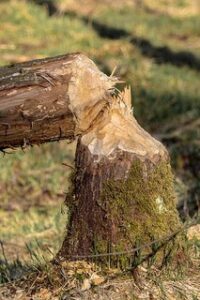
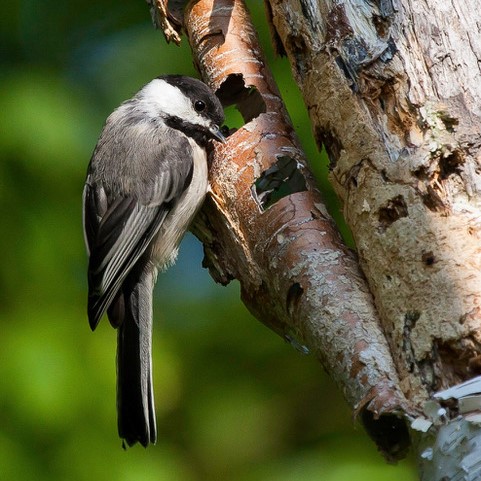
Chickadees
Poecile atricapillus, the Black-capped Chickadee, is a common neighbor at Long Lake. Although largely out of sight and relatively silent in summer, these birds are non-migratory, and with the fall of autumn leaves come flocking, the occasional “fee-bee” call of summer giving way to the familiar “Chicka-dee-dee-dee.”
If we listen carefully we can detect multiple calls, and the birds do use them for communication. The familiar Chicka-dee-dee can be an alarm call, with the number of “de’s” corresponding to the threat level. Other birds which tend to associate with Chickadee flocks do respond to their alarm calls, even when that species has no similar alarm call of its own. Other interesting facts concerning this tiny bird, according to the Cornell University Ornithology Lab, include:
- When you see them take one seed at a time and fly off with it, it may be to eat it, or it may be to hide it. Each morsel is placed in a different spot, and the bird can remember literally thousands of hiding places. To accommodate that kind of memory, every autumn brain neurons die and are replaced with new ones.
- The birds form flocks in the fall, and each flock has a social hierarchy. Some birds, known as “winter floaters,” associate with multiple flocks, and may have a different social rank in different flocks.
- Although they form flocks in winter and find mates for the following year then, each bird sleeps alone. Even in sub-zero temperatures they find a hole in trees, which they can easily excavate in dead wood.
- The oldest known Chickadee was re-captured in Minnesota 11 ½ years after it was originally banded.
Black oil sunflower seed is a favorite food, and they also enjoy suet. Cleanup of sunflower seed shells in the spring is a small price to pay for the joy of having them near the window all winter.
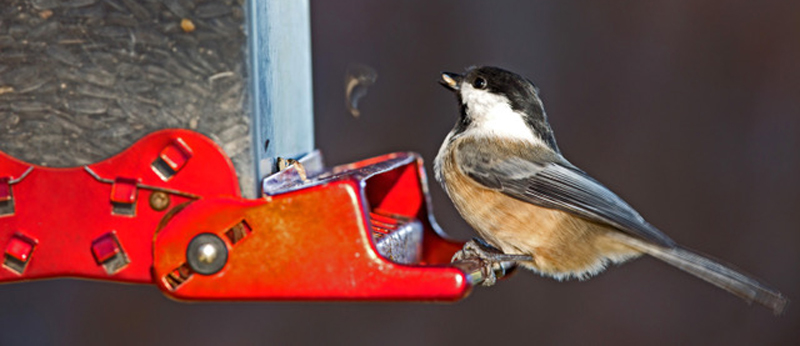
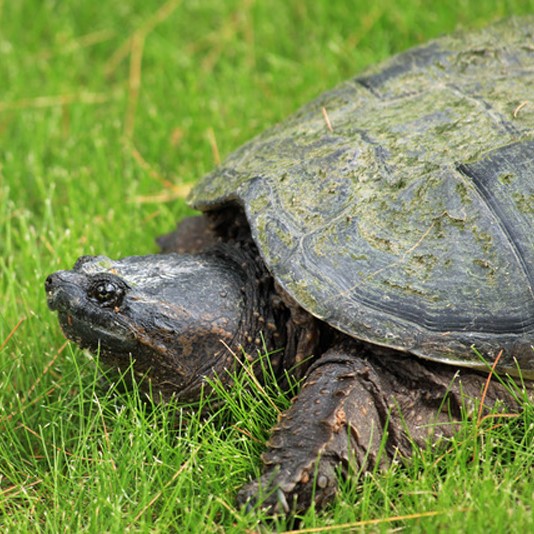
Snapping Turtles
Of the 21 species of reptiles in Wisconsin, 11 are turtles. Here we will focus on the largest and heaviest, the common snapping turtle, Chelydra serpentine.
Like all turtles, the snapper is cold blooded, obtaining heat from the sun. Unlike the familiar painted turtle, snappers seldom crawl onto logs to sun themselves, but often float at the surface. They are almost entirely aquatic, with females coming to shore to lay eggs primarily in May and June. They will travel some distance to find a suitable egg laying site, having been found as far as a mile from water. Fortunately, the attempted housebreaking depicted in the side photo is not common behavior.
On land, snapping turtles can be quite aggressive. They should be handled only by those who truly know how. Lifting by the sides of the upper shell is dangerous, as they have a very long and mobile neck-the species name serpentine means “snake-like.” Their bite can easily sever a finger. Lifting by the tail could cause them permanent spinal damage. It is best to just watch them from a distance. In the water they are not a threat to humans, and when encountered they will swim away or hide in the muck or under vegetation.
Adult turtles have few predators, but the eggs are another matter. Nests are frequently raided by raccoon and skunks. Eggs that survive hatch in 80 to 90 days, although some overwinter in the nest. When a tiny turtle is seen heading for water in the spring, if is from an egg laid the prior year.
Snapping turtles are omnivorous, eating plants and just about any animal or fish they can catch, although their reputation as a duckling predator has been highly exaggerated. Younger turtles will forage for food, but the big ones hang motionless in the water, hunting by ambush.
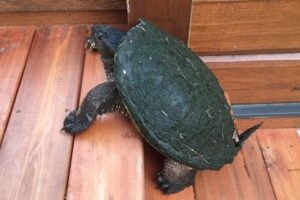

River Otters
One of the most fun-loving furry critters in Long Lake is the River Otter, sometimes fondly referred to as a ‘Stick Tail.’ We lake residents are very fortunate to have this mammal as one of our entertaining neighbors as otters are mainly located only in the northern portion of Wisconsin.
Not to be confused with the muskrat, who swims in a straight line displaying definite purpose, otters are very playful. According to the Wisconsin DNR they like to wrestle, chase other otters, and play capture and release with live prey. In winter they will take three or four bounding steps and then slide across the snow for 5-15 feet.
The otter’s diet is an aquatic mixture of fish, birds, and vegetation. After diving for food they resurface, float on their backs and use their tummy as a dining table. You will see them just laying there munching away on their delectable harvest.
For homes, otters use abandoned beaver lodges, hollowed out logs, or brush piles. The mama otter will give birth to two to four pups in April or May after a one year pregnancy. Babies are born about 4.5 inches long, furry, with their eyes closed for about a month. In eight to ten weeks, they are ready to hit the water. After turning one year of age, otters leave the family in search of a territory to call their own. Due to their voracious eating habits, an otter needs to claim a territory as large as three square miles.
Interesting Facts
Measurements: length: 2-4 feet; weight: 44-82 pounds; tail length: 1-1.5 feet
Life Expectancy: 10-15 years
Extra Tidbits: largest member of the weasel family; makes high-pitched scream when fighting or mating and will snort when confused or surprised; can dive to depths of more than 40 feet!
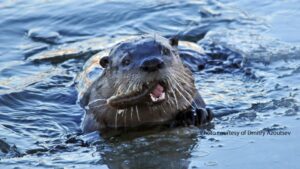

Wild Turkeys
While once present in Wisconsin, wild turkeys completely disappeared due to loss of habitat during the lumbering era of the Nineteenth Century, the last known bird having been harvested in 1881. In 1976 Wisconsin traded ruffed grouse to Missouri in exchange for turkeys, releasing 29 birds in January of that year, with 334 more to follow. The reintroduction success has been phenomenal, with more than 45,000 birds being registered in the Spring 2016 hunting season alone.
The wild turkey is Wisconsin’s largest game bird, measuring 2.5 to 3 feet in height, with the male (gobbler) weighing in at 17 to 21 pounds and the hen at 8 to 11 pounds. Wingspans range from about 3 to 4.5 feet. Each bird has 5,000 to 6,000 feathers, which provide wintertime warmth, assistance in flight and which are sported in mating rituals.
Turkeys stay in flocks of 5 to 50 birds. The flock utilizes a home range of more than 1,000 acres. They prefer open grassy or grain field areas next to hardwood forests. The forest provides refuge from predators and a roosting place at night. Food consists of plants, insects, acorns, seeds and fruit.
Turkeys are wary, shy birds with excellent eyesight. They see in color, and have a 270 degree field of vision. They are capable of flying at over 55 miles per hour, but only for short distances. They prefer to run from predators, having a top speed of about 25 miles per hour.
While turkeys are North American birds, they originally derived their name, somewhat indirectly, from the nation of Turkey. They bear some resemblance to the guinea fowl of central Europe, sometimes called “turkey fowl” because originally imported there from Turkey. They are different birds, but somehow the name just stuck.
Had Benjamin Franklin had his way the turkey, not the bald eagle, would be our National Bird. Ben lost that argument.
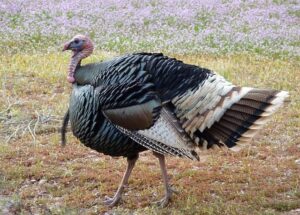
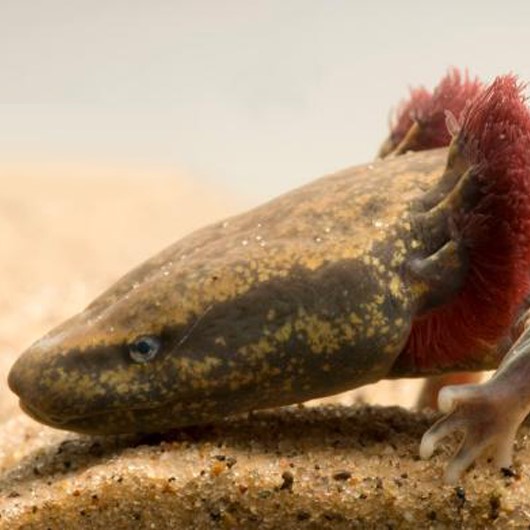
Mudpuppies
A Mudpuppy (common to Long Lake) is a large, aquatic salamander with a flat, square head, small eyes and distinctive a pair of feathery gills on either side of its head. The Mudpuppy name is thought to derive from either the external gills which are reminiscent of canine ears, or from the erroneous belief that they make vocalizations similar to those of a dog.
The smooth skin of the adult common mudpuppy can differ in coloration between red, black and grey-brown, with variable scattered blue-black spots across its back or occasionally faint stripes. The underside of the body is greyish and may also have dark spots. The juveniles have a highly distinctive pattern, with broad, dark stripes with yellow edges along the back.
The tail is short and flattened and the legs are short and slender, but well developed, with four toes on each foot. The size of an adult Mudpuppy is 8”-12” (20-30 cm) long.
Mating between the common mudpuppy occurs between autumn and winter and the female lays between 40 to 150 eggs. The female guards the eggs until they hatch.
The common mudpuppy relies mostly on its sense of smell to detect prey composed mainly of aquatic salamanders or small fish and their eggs.
The common mudpuppy is active all year, although it is most active from late autumn to spring. It is primarily nocturnal, but may sometimes emerge during the day in habitats where the water is cloudy.
An entirely aquatic species, the common mudpuppy inhabits freshwater ponds, lakes, streams, canals, reservoirs and rivers. It lives close to the bottom where there are rocks and logs for shelter. The range of the common mudpuppy extends south from eastern Canada to northern Georgia in the USA.
The common mudpuppy is sometimes caught by fishermen then discarded onto land due to the false belief that it is poisonous or detrimental to the game fish population, which it is not.

